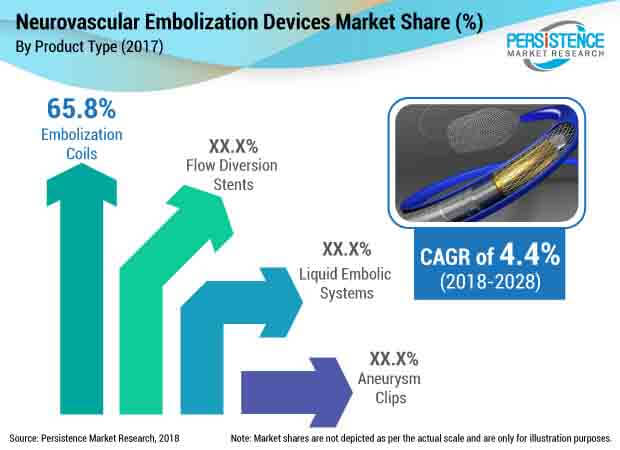Neurovascular Embolization Devices Market Segmented By Epicardial LAA closure devices and Endocardial LAA closure devices in Diagnostic Laboratories, Hospitals, Academic Research Institutes
Industry: Healthcare
Published Date: December-2018
Format: PPT*, PDF, EXCEL
Delivery Timelines: Contact Sales
Number of Pages: 167
Report ID: PMRREP25969
The neurovascular embolization devices market is mainly dominated by the key players, who are adopting the strategies of acquisitions and product launches to compete in market. The key players, such as Johnson and Johnson Services, Inc., Terumo Corporation, Stryker Corporation and Medtronic plc., hold maximum share in terms of revenue in the global neurovascular embolization devices market. These companies are constantly making efforts to launch new products. Additionally, the companies operating in the neurovascular embolization devices market are focusing on acquisitions and mergers to expand their business.
For instance, Stryker acquired Concentric Medical (Neurovascular division of Boston Scientific), a developer, manufacturer and promoter of minimally invasive products, and expanded its neurovascular product portfolio, and acquired Surpass Medical, a company engaged in the development and commercialization of the NeuroEndoGraft family of next-generation flow diversion stent technology to treat brain aneurysms.
The prevalence of cerebral aneurysms is increasing constantly. Brain aneurysm is equally prevalent in individuals of all age groups, however individuals 35 years and above are at high risk. The growing prevalence of cerebral aneurysms is projected to fuel the growth of the neurovascular embolization devices market.
The severe risks associated with intracranial aneurysms, such as permanent loss of cognitive functions and neurological disorders, is surging the demand for neurovascular embolization devices for the treatment. The increasing mortality rate due to brain aneurysms is expected to increase the need for neurovascular embolization devices.
Technological advancements have helped to detect the size, type, shape and other aspects of brain aneurysm at right time to prevent adverse effects. Various government and non-profit organizations are making efforts to spread awareness regarding brain aneurysm and other neurovascular conditions, which is projected to driving the growth of the neurovascular embolization devices market.
For instance, the Brain Aneurysm Foundation helps people to join groups and contact patients and surgeons, read facts, blogs and videos and gain knowledge for better treatment options. Other organizations, e.g., the Bee Foundation, Brain Aneurysm Foundation, the Aneurysm and AVM Foundation, the Lisa Colagrossi Foundation, and Headway, are also making similar efforts to educate the general population. September was declared as the ‘National Brain Aneurysm Awareness Month’ in 2011 by the US Senate as an attempt to make people aware of brain aneurysms.

This section of the report features profiles of key players operating in the neurovascular embolization devices market based on their market shares, differential strategies, product offerings, marketing approach and company dashboard.
Some of the key players featured in this report include Johnson Services, Inc., Medtronic plc, Integra LifeSciences Corporation, Penumbra Inc., Resonetics Llc., B. Braun Melsungen AG., Acandis GmbH, Stryker Corporation, Balt Extrusion S.A., and Terumo Corporation. The key manufacturers of neurovascular embolization devices are focusing on acquisitions and mergers to extend their product portfolio. The companies are conducting conferences and training sessions in hospitals and institutes to educate surgeons and practitioners about the novel neurovascular embolization devices.
Aneurysm clips are small titanium clips that perform permanent occlusion of the aneurysm. These devices block the blood flow to the aneurysm by coiling or clipping the structure, gluing the vessel or diverting the blood flow. In this report, we have not considered consumables and therapies used for the treatment of aneurysms. Embolization coils are soft metal coils that are placed in the aneurysms to block the blood flow in the region and isolate the region from normal blood flow.
PMR conducted a research study on the neurovascular embolization devices market for the forecast period 2018 to 2028. The neurovascular embolization devices market report offers a comprehensive evaluation of the business opportunities prevailing in the neurovascular embolization devices market along with insights on the neurovascular embolization devices trend, disease incidences, and awareness level for neurovascular embolization devices and neurovascular embolization devices market competition. The report elaborates the macroeconomic factors influencing the dynamics of the neurovascular embolization devices market and its futuristic potential.
The report offers a comprehensive taxonomy of the neurovascular embolization devices market based on product type, end user and region. The neurovascular embolization devices market is categorized into four types of products that are embolization coils, flow diversion stents, liquid embolic systems and aneurysm clips.
The end users in the neurovascular embolization devices market are hospitals and outpatient centers. The neurovascular embolization devices market has been analyzed across regions of North America, Latin America, Europe, Asia Pacific (APAC), and MEA.
Some of the additional questions addressed in this report on neurovascular embolization devices market-
The neurovascular embolization devices market has been estimated based on supply-demand approach. The market was first calculated based on implantation of LAA closure devices volume conducted in different region/countries. The test volume was estimated based on the incidence rate of brain aneurysms and neurovascular disorders related to intracranial aneurysms in top 20 countries globally. Other qualitative factors analyzed during test volume estimation include awareness level for neurovascular embolization devices, demand for minimally invasive surgeries and others.
This information is further validated with rigorous primary research (including interviews, surveys, in-person interactions, and viewpoints of seasoned analysts) and secondary research (including verified paid sources, authentic trade journals, and resourceful databases). The research study on neurovascular embolization devices market also includes top trends and macro as well as micro economic factors shaping the neurovascular embolization devices market. With this approach, the report on neurovascular embolization devices market anticipates the industry attractiveness of every major segment in neurovascular embolization devices over the forecast period.
To know more about delivery timeline for this report Contact Sales
